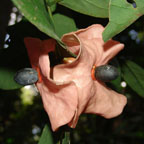
|
Aptandraceae Miers
|
Distribution Map
Photographs
Anacolosa
- Anacolosa clarkii
- Series
of photos. Flowers, fruit, bark, etc. From Laos. Link
goes to the BIOTIK web site.
- Anacolosa insularis
- Anacolosa frutescens
- Photos.
Excellent photos of flowering specimens from the Philippines. Link
goes to PhytoImages.
- Photos. Go to Olacaceae
and click on this species. Link goes to
Plants of Southeast Asia by Ferry Slik.
- Illustration
from Flora Malesiana 10 24 1984. Link
goes to Borneo
Tree Images. James K. Jarvie, Beth Dart, Diane Holland.
- Anacolosa pervilleana.
- Fruiting shoots.
Madagascar, Antsiranana, Ambilomagodro, 12º53'S 049º10'E. [MO
specimen: Rakotonandrasana 1016 RIR]. Photos by Richard
Randrianaivo. Link goes
to TROPICOS.
- Photos
Prov Tuliar Parc Nat Zombitse, Madagascar. Photos 13 Jan. 2006 by C.
Davidson (coll. Z. Rogers 863). Link
goes to Flora of the World.
- Photos.
Z. Rogers et al. 1157. Link goes to
PhytoImages.
- Illustration.
From Capuron (1968). Note
the anthers dehisce by pores along a rim, very much like Phanerodiscus
and Cathedra. This conflicts with the statement by Kuijt
(2015) "Neither
Anacolosa nor Cathedra, both placed
in Aptandraceae by Nickrent et al. (2010), share such
fundamental features, having a more regular anther
structure; for this reason, a systematic placement in
Olacaceae remains more appropriate." Thus
both morphology and molecular data (see Phylogeny below) show
that Anacolosa and Cathedra are part
of Aptandraceae.
Aptandra
- Aptandra caudata
- Aptandra tubicina
- Plant with flowers.
Colombia, Caqueta. Gentry and Sanchez (No.65181). Link
goes to TROPICOS.
- Aptandra zenkeri
- Photos.
Province Ogooue-Ivindo, Lope National Park. Sommet Main, Gabon. Link
goes to Flora of the World.
- Fruiting plant. Each fruit has
an expanded (accrescent) calyx. Ibadan, Nigeria. Slide no. 9637
archived at K, taken by J. Lowe Sept. 16, 1971.
- Plant with fruit, photo
1, photo 2,
Gabon. Photo by A. Gentry (No. 33089). Link
goes to TROPICOS.
- Fruits,
Gabon. Photo by A. Gentry (no. 33530). Link
goes to TROPICOS.
- Illustration.
From Sleumer (1935).
- Aptandra sp.
- Photos.
From the Aguajal Mamule research site, Amazonas, Brazil. J. E.
Househlder no. 1316. The flowers are on very long pedicels and the
calyx envelops the fruit more than half its length. Likely a new
species. Link goes to Atrium
Biodiversity Information System
Cathedra
- Cathedra acuminata
- Photo1.
Photo2.
Plant in fruit. Mato Grosso, Brazil. Link
goes to Neotropical Plants image database at Kew.
- Plant with flowers,
Venezuela. Photo by A. Gentry (No. 24806). Link
goes to TROPICOS.
- Fruits. Peru,
Loreto. Collected by Thomas Croat (19059), Aug. 1972. Link
goes to TROPICOS.
- Photos.
Pants in flower and fruit. Reserva Nacional Pacaya-Samiria,
Loreto, Peru. 14-15 Nov. 2008. Flowers (Vasquez, Ro 34913),
fruits (Vasquez, Ro 34966). Link goes to
Flora of the World.
- Herbarium specimen,
showing young fruits. Labels are: 1) annular prophyll, 2) calyx, 3)
base of receptacular disk - expands to cover most of drupe, 4) top
of disk (base of perianth?), 5) style. Specimen from Missouri
Botanical Garden herbarium (MO). Photo by D. L. Nickrent.
- Herbarium specimen.
Mature fruit. Labelling as above. Photo by D. L. Nickrent.
- Herbarium specimen.
Fruiting specimen. Photo by D. L. Nickrent.
- SEM
images of stamens. Link goes to
PhytoImages.
- Line
drawing of flower dissections from material present at
Kew. Note the anthers dehisce by pores along a rim, very much
like Phanerodiscus. This conflicts with the statement
by Kuijt (2015): "Neither Anacolosa nor Cathedra,
both placed in Aptandraceae by Nickrent et al. (2010), share
such fundamental features, having a more regular anther
structure; for this reason, a systematic placement in Olacaceae
remains more appropriate." Thus, molecular data (see Phylogeny
below) and morphology both show that Anacolosa and Cathedra
are part of Aptandraceae.
- Cathedra gardneriana (with Schoepfia
and Tetrastylidium)
- Cathedra sp.
Chaunochiton
- Chaunochiton kappleri
- A
number of photos Los Amigos Conservation
Area, Rio Los Amigos, Madre de Dios, Peru. J. Janovec et al. no.
2551. Photos by John Janovec. Link
goes to Atrium Biodiversity Information System.
- Photos.
Mato Grosso, Brazil. Link goes to
Neotropical Plants image database at Kew.
- Photos.
Link goes to Neotropical Live Plants, Field Museum in Chicago.
- Herbarium specimen,
Note the very large accrescent calyx. Specimen from Missouri
Botanical Garden herbarium (MO). Photo by D. L. Nickrent.
- At first glance the anthers
appear to be valvate, with lobes of the valves hanging down along
the sides of the filament. But when examined more closely, the
anthers have small, nearly porose openings along the apical
region. This is similar to the condition seen in Cathedra
and Phanerodiscus (see
below) which have porose areas that occur along a slit-like region
that marks the junction of the anther locules. Photos by D. L.
Nickrent.
- Chaunochiton loranthoides
- Herbarium specimen. The
large, colorful corolla suggests the plants are bird pollinated -
overall resembling Loranthaceae to a remarkable degree. Specimen
from Missouri Botanical Garden herbarium (MO). Photo by D. L.
Nickrent.
- Drawing.
Flower bud, flower, two types of anthers and fruit with
accrescent calyx. Figure 3-20 from Kuijt (1969) with labels added.
- Photo of
the anthers of this species. This appears to be the anther
type 2 illustrated by Kuijt (above). Photo by D. L. Nickrent.
- Chaunochiton sp.
- Photos.
Rio Aracá Igapó research site, Amazonas, Brazil. J. E.
Householder no. 2489. Link
goes to Atrium Biodiversity Information System
Harmandia
- Harmandia mekongensis
- Photograph 1 and 2
of a fruiting specimen showing the red, accrescent calyx. Viet
Nam. Photos by Phan Ke Loc.
- Photos.
Excellent photos of bark, leaves, and fruit. Link
goes to Flickr.
- Illustration from Tree Flora of
Sabah and Sarawak, Vol. 1. (Olacaceae, by Lesmy Tipot, 1995, E.
Soepadmo and K. M. Wong, editors, Sabah Forstry Dept., Forest Res.
Inst. Malaysia, Sarawak Forestry Dept.).
- Illustration,
modified from Pierre,
L.,
1884-1895. Flore forestiere de la Cochinchine, vol. 3: t. 264 ,
fig. B [Drawing by E. Delpy]
Hondurodendron
- Hondurodendron urceolatum. A monotypic genus, recently
described by Ulloa
et
al. (2010). All the following photos are of plants
from Parque Nacional El Cusuco in northwest Honduras. Photos of
intact fruits by Jonathan Kolby. Photos of dissected flowers and
pollen by D. L. Nickrent.
- Fruiting branch
intact on small tree, clipped
branch on ground, and vegetative
branch showing leaf arrangement. The bark
is slightly rough, shallowly fissured, and lenticellate.
- Fruit intact and dissected.
The calyx greatly enlarges upon fruiting (accrescent), completely
surrounding the ovary and even projecting beyond as a flared limb.
Although other neotropical Aptandraceae (Aptandra,
Chaunochiton) have an accrescent calyx, theirs flare
outward and do not wrap tightly around the fruit. The local people
refer to this fruit as “guayabillo”, “guayabillo de montaña” or
“guayaba de montaña”, all variants of “guayaba” or guava (Psidum
guajava) whose fruit it superficially resembles.
- Hondurodendron is is
dioecious with extremely small unisexual flowers. These male
flowers (fixed in alcohol) are less than two mm wide. The
calyx is minute, tucked underneath the slightly pubescent
petals with apical thickenings. The female flowers (not
shown) are of similar size. It is an amazing that the calyx
which starts out so small enlarges so much in fruit!
- This male flower, with the petals removed, has stamens
alternating with the disk lobes. The tiny stamens
are terminated by morphologically unusual anthers where each of the
three lobes dehisces
apically by a longitudinal valve. Compared to other Aptandraceae,
the pollen of Hondurodendron
is rather unspecialized (scale bar = 6 µm).
Ongokea
- Ongokea gore
- Photos.
Showing flowers and bark features. Lope National Park,
Moyen-Ogooue Province, Gabon. Photos 19 April 2006 by C.
Davidson. Link goes to
Flora of the World.
- Illustration
(as O. kamerunensis, a
synonym of O. gore).
- Map,
illustration,
photos. From Protabase.
- Herbarium specimen, Missouri
Botanical Gardens (MO). Photo by D. L. Nickrent.
- Fruits showing the
accrescent calyx. From Agroherbinc.com.
Phanerodiscus
- Phanerodiscus capuronii
- Fruiting plant (fruit
somewhat malformed). Madagascar, Prov. Toamasina, Ambila-Lemaitso.
Photo by G. E. Schatz, [no. 3439, Schatz et al. 28 Jan 1993]. See
Malécot, Schatz & Bosser (2003). TROPICOS
link HERE.
- Phanerodiscus diospyroidea
- Photos of
various parts of the plant. The flowers have a very Ximenia-like
pubescence
on petals! The fruit has the bizarre induvium composed of the
induvial cupule nd the induvial membrane. See Malécot
et al. (2003) for details of this and other species of Phanerodiscus.
DIANA, Mosorolava, Ampombiantambo, Madagascar. Photos by Fidy
Ratovoson. Link goes to
TROPICOS.
- SEM photographs of flowers rehydrated from an herbarium specimen
[Capuron 11265, Ouest (Nord) Plateau Caleaire de l'Ankarund,
Madagascar]. Detached
petal
with stamen. Note two types of dense trichomes on the inner
surface of the petal. The anther is extrorse, hence it
dehisces towards the petal hairs. Closer view of the opposite
side of the anther
showing the horseshoe-shaped line of pores where pollen is dehisced.
Sometimes the pollen comes out of the pores in cylindrical masses,
like toothpaste being squeezed from a tube! Photos by D. L. Nickrent
with assistance from Hannah Banks, Royal Botanic Gardens, Kew.
- Photos.
Link goes to Flora of
the World.
Phylogeny
- The first molecular phylogeny of Olacaceae s. lat. was by Malécot and
Nickrent (2008). A pdf file for that paper can be seen by clicking
HERE.
- A reclassification of the families of Santalales was by Nickrent et
al. (2010). A pdf file for that paper canbe seen by clicking HERE.
- For a fully resolved molecular phylogeny of all eight genera for the
family Aptandraceae, see Ulloa et al. (2010) HERE.
- A multigene phylogeny for the order Santalales was by Su et al.
(2015). A pdf file for that paper canbe seen by clicking HERE.

Last updated: 15-Nov-20 / dln


